Business Research: Reflective Journal - Business Student's Insights
VerifiedAdded on 2020/05/08
|8
|1687
|170
Journal and Reflective Writing
AI Summary
This reflective journal presents a student's journey through a business research project focused on the role of ubiquitous media in business. The research begins with an introduction to the ubiquitous media concept and its prevalence in modern business environments. The student details their learning process, outlining research objectives such as defining ubiquitous media, determining its usage, investigating how ubiquitous surveillance improves business performance, and exploring related theories. The journal reflects on the exploration of literature, including the application of ubiquitous media for monitoring employee activities and analyzing customer preferences. It also discusses the practical assessment of ubiquitous media, research methodologies, and the challenges faced, such as limited resources and time constraints. The student employed both qualitative and quantitative methods, including surveys and data analysis using MS Excel. The research findings highlight the advantages of ubiquitous surveillance in business operations, such as improved consumer behavior monitoring, while also acknowledging the associated cyber threats and costs. The conclusion emphasizes the importance of effective implementation of ubiquitous surveillance for organizational advancement.
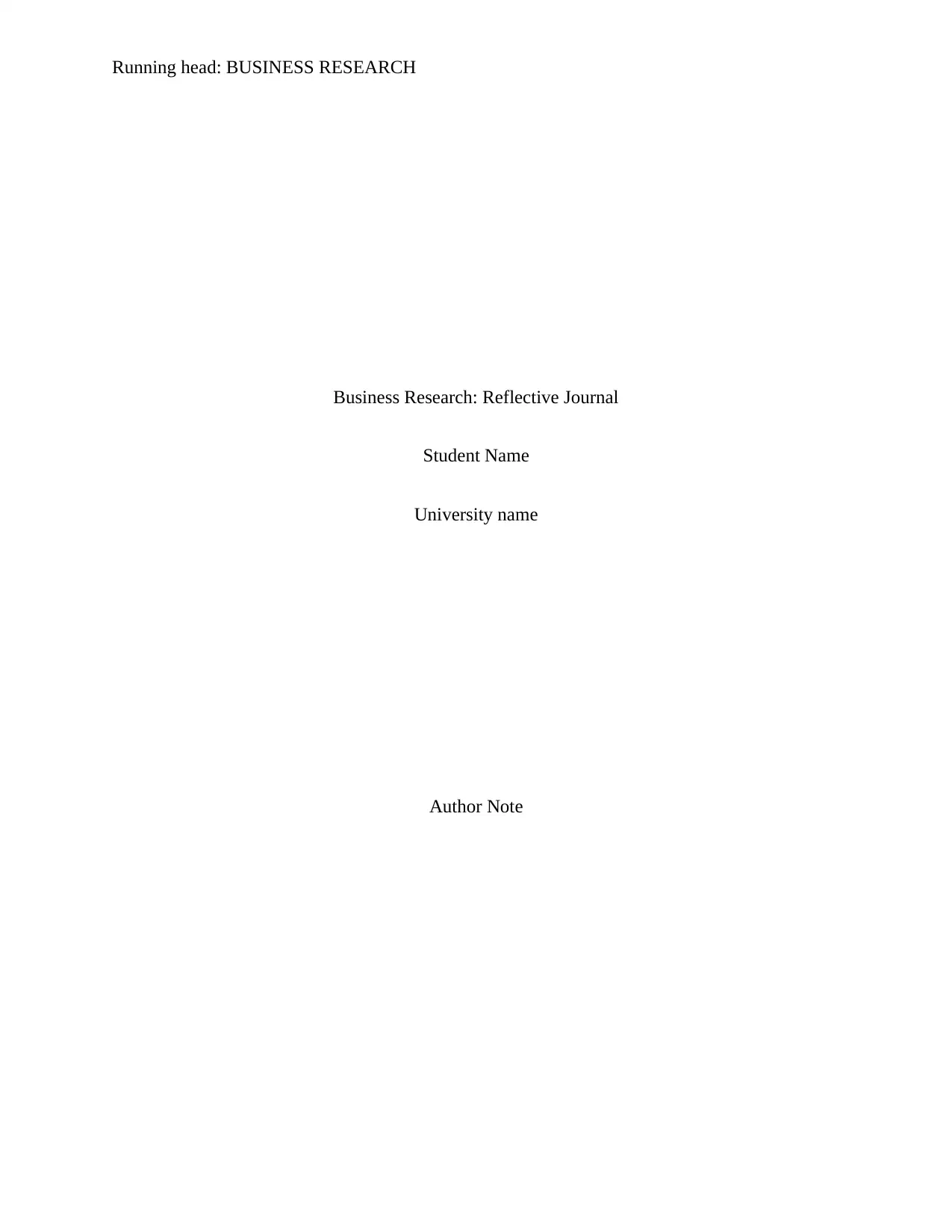
Running head: BUSINESS RESEARCH
Business Research: Reflective Journal
Student Name
University name
Author Note
Business Research: Reflective Journal
Student Name
University name
Author Note
Paraphrase This Document
Need a fresh take? Get an instant paraphrase of this document with our AI Paraphraser
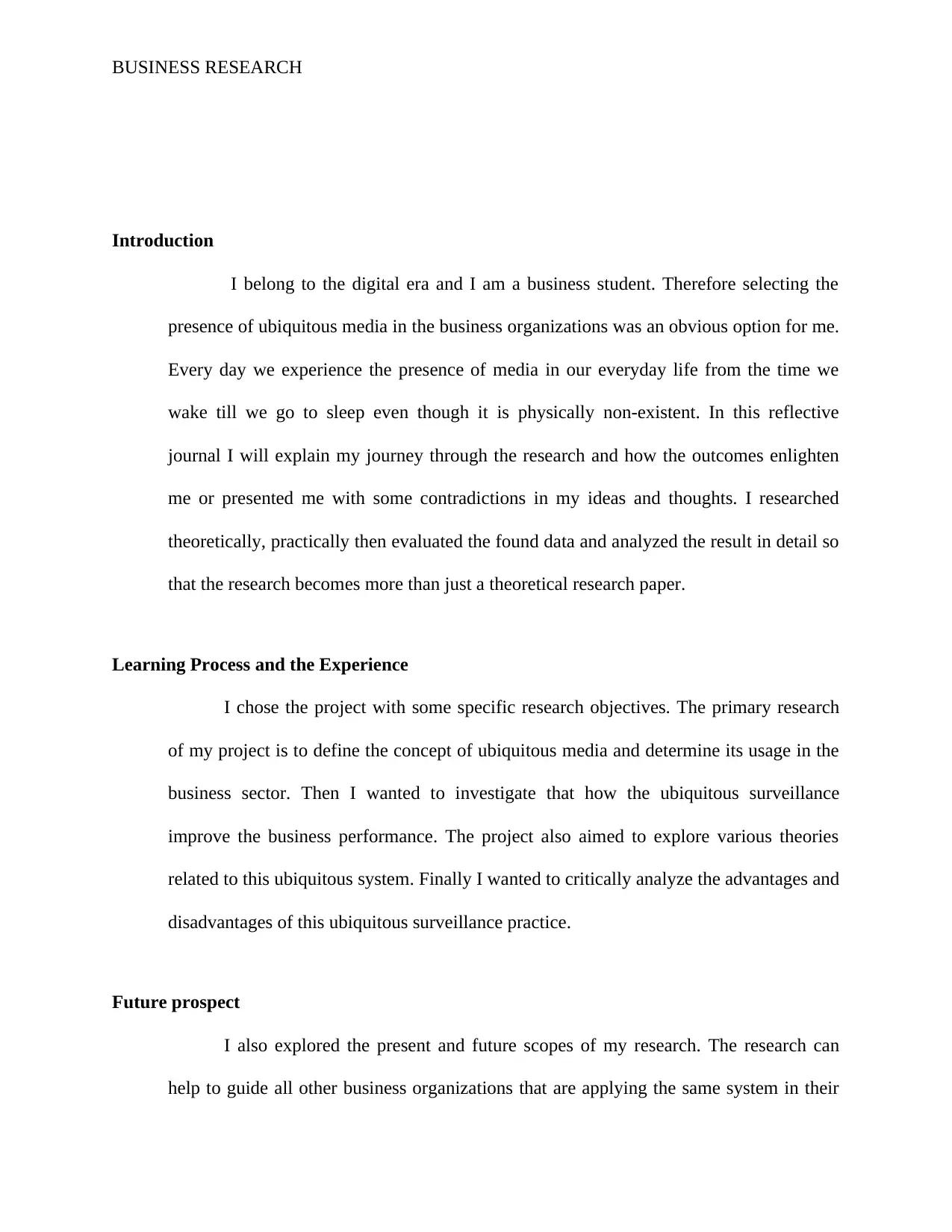
BUSINESS RESEARCH
Introduction
I belong to the digital era and I am a business student. Therefore selecting the
presence of ubiquitous media in the business organizations was an obvious option for me.
Every day we experience the presence of media in our everyday life from the time we
wake till we go to sleep even though it is physically non-existent. In this reflective
journal I will explain my journey through the research and how the outcomes enlighten
me or presented me with some contradictions in my ideas and thoughts. I researched
theoretically, practically then evaluated the found data and analyzed the result in detail so
that the research becomes more than just a theoretical research paper.
Learning Process and the Experience
I chose the project with some specific research objectives. The primary research
of my project is to define the concept of ubiquitous media and determine its usage in the
business sector. Then I wanted to investigate that how the ubiquitous surveillance
improve the business performance. The project also aimed to explore various theories
related to this ubiquitous system. Finally I wanted to critically analyze the advantages and
disadvantages of this ubiquitous surveillance practice.
Future prospect
I also explored the present and future scopes of my research. The research can
help to guide all other business organizations that are applying the same system in their
Introduction
I belong to the digital era and I am a business student. Therefore selecting the
presence of ubiquitous media in the business organizations was an obvious option for me.
Every day we experience the presence of media in our everyday life from the time we
wake till we go to sleep even though it is physically non-existent. In this reflective
journal I will explain my journey through the research and how the outcomes enlighten
me or presented me with some contradictions in my ideas and thoughts. I researched
theoretically, practically then evaluated the found data and analyzed the result in detail so
that the research becomes more than just a theoretical research paper.
Learning Process and the Experience
I chose the project with some specific research objectives. The primary research
of my project is to define the concept of ubiquitous media and determine its usage in the
business sector. Then I wanted to investigate that how the ubiquitous surveillance
improve the business performance. The project also aimed to explore various theories
related to this ubiquitous system. Finally I wanted to critically analyze the advantages and
disadvantages of this ubiquitous surveillance practice.
Future prospect
I also explored the present and future scopes of my research. The research can
help to guide all other business organizations that are applying the same system in their
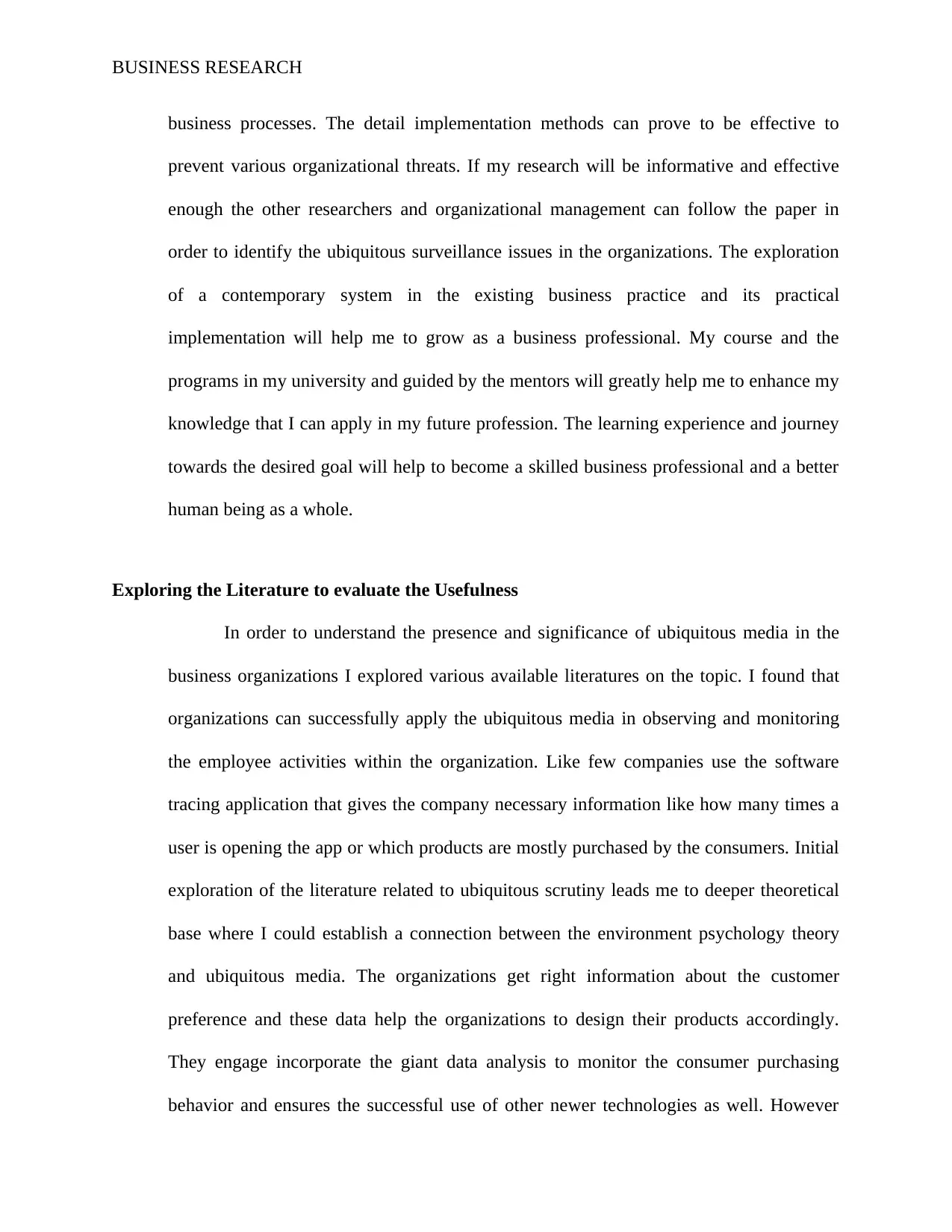
BUSINESS RESEARCH
business processes. The detail implementation methods can prove to be effective to
prevent various organizational threats. If my research will be informative and effective
enough the other researchers and organizational management can follow the paper in
order to identify the ubiquitous surveillance issues in the organizations. The exploration
of a contemporary system in the existing business practice and its practical
implementation will help me to grow as a business professional. My course and the
programs in my university and guided by the mentors will greatly help me to enhance my
knowledge that I can apply in my future profession. The learning experience and journey
towards the desired goal will help to become a skilled business professional and a better
human being as a whole.
Exploring the Literature to evaluate the Usefulness
In order to understand the presence and significance of ubiquitous media in the
business organizations I explored various available literatures on the topic. I found that
organizations can successfully apply the ubiquitous media in observing and monitoring
the employee activities within the organization. Like few companies use the software
tracing application that gives the company necessary information like how many times a
user is opening the app or which products are mostly purchased by the consumers. Initial
exploration of the literature related to ubiquitous scrutiny leads me to deeper theoretical
base where I could establish a connection between the environment psychology theory
and ubiquitous media. The organizations get right information about the customer
preference and these data help the organizations to design their products accordingly.
They engage incorporate the giant data analysis to monitor the consumer purchasing
behavior and ensures the successful use of other newer technologies as well. However
business processes. The detail implementation methods can prove to be effective to
prevent various organizational threats. If my research will be informative and effective
enough the other researchers and organizational management can follow the paper in
order to identify the ubiquitous surveillance issues in the organizations. The exploration
of a contemporary system in the existing business practice and its practical
implementation will help me to grow as a business professional. My course and the
programs in my university and guided by the mentors will greatly help me to enhance my
knowledge that I can apply in my future profession. The learning experience and journey
towards the desired goal will help to become a skilled business professional and a better
human being as a whole.
Exploring the Literature to evaluate the Usefulness
In order to understand the presence and significance of ubiquitous media in the
business organizations I explored various available literatures on the topic. I found that
organizations can successfully apply the ubiquitous media in observing and monitoring
the employee activities within the organization. Like few companies use the software
tracing application that gives the company necessary information like how many times a
user is opening the app or which products are mostly purchased by the consumers. Initial
exploration of the literature related to ubiquitous scrutiny leads me to deeper theoretical
base where I could establish a connection between the environment psychology theory
and ubiquitous media. The organizations get right information about the customer
preference and these data help the organizations to design their products accordingly.
They engage incorporate the giant data analysis to monitor the consumer purchasing
behavior and ensures the successful use of other newer technologies as well. However
⊘ This is a preview!⊘
Do you want full access?
Subscribe today to unlock all pages.

Trusted by 1+ million students worldwide
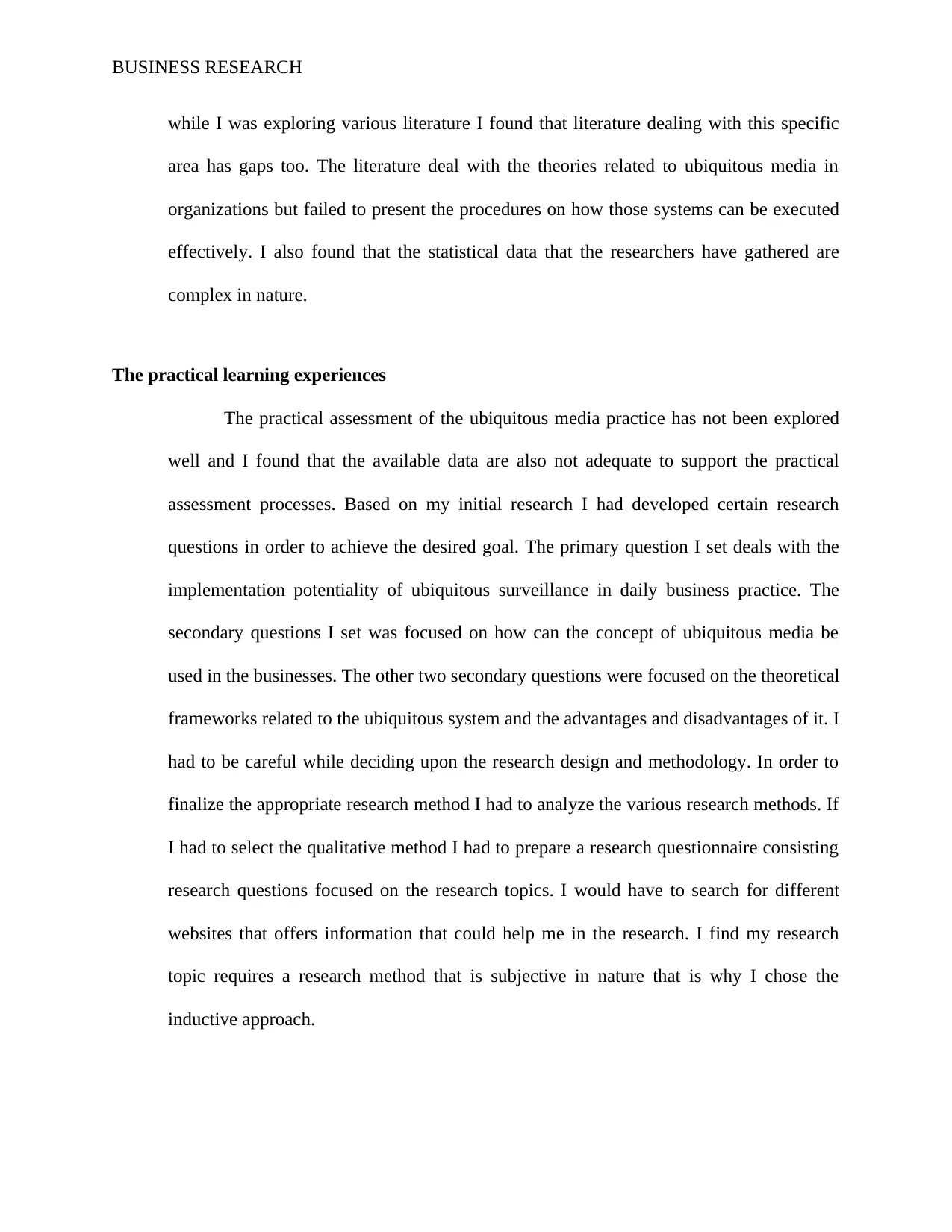
BUSINESS RESEARCH
while I was exploring various literature I found that literature dealing with this specific
area has gaps too. The literature deal with the theories related to ubiquitous media in
organizations but failed to present the procedures on how those systems can be executed
effectively. I also found that the statistical data that the researchers have gathered are
complex in nature.
The practical learning experiences
The practical assessment of the ubiquitous media practice has not been explored
well and I found that the available data are also not adequate to support the practical
assessment processes. Based on my initial research I had developed certain research
questions in order to achieve the desired goal. The primary question I set deals with the
implementation potentiality of ubiquitous surveillance in daily business practice. The
secondary questions I set was focused on how can the concept of ubiquitous media be
used in the businesses. The other two secondary questions were focused on the theoretical
frameworks related to the ubiquitous system and the advantages and disadvantages of it. I
had to be careful while deciding upon the research design and methodology. In order to
finalize the appropriate research method I had to analyze the various research methods. If
I had to select the qualitative method I had to prepare a research questionnaire consisting
research questions focused on the research topics. I would have to search for different
websites that offers information that could help me in the research. I find my research
topic requires a research method that is subjective in nature that is why I chose the
inductive approach.
while I was exploring various literature I found that literature dealing with this specific
area has gaps too. The literature deal with the theories related to ubiquitous media in
organizations but failed to present the procedures on how those systems can be executed
effectively. I also found that the statistical data that the researchers have gathered are
complex in nature.
The practical learning experiences
The practical assessment of the ubiquitous media practice has not been explored
well and I found that the available data are also not adequate to support the practical
assessment processes. Based on my initial research I had developed certain research
questions in order to achieve the desired goal. The primary question I set deals with the
implementation potentiality of ubiquitous surveillance in daily business practice. The
secondary questions I set was focused on how can the concept of ubiquitous media be
used in the businesses. The other two secondary questions were focused on the theoretical
frameworks related to the ubiquitous system and the advantages and disadvantages of it. I
had to be careful while deciding upon the research design and methodology. In order to
finalize the appropriate research method I had to analyze the various research methods. If
I had to select the qualitative method I had to prepare a research questionnaire consisting
research questions focused on the research topics. I would have to search for different
websites that offers information that could help me in the research. I find my research
topic requires a research method that is subjective in nature that is why I chose the
inductive approach.
Paraphrase This Document
Need a fresh take? Get an instant paraphrase of this document with our AI Paraphraser
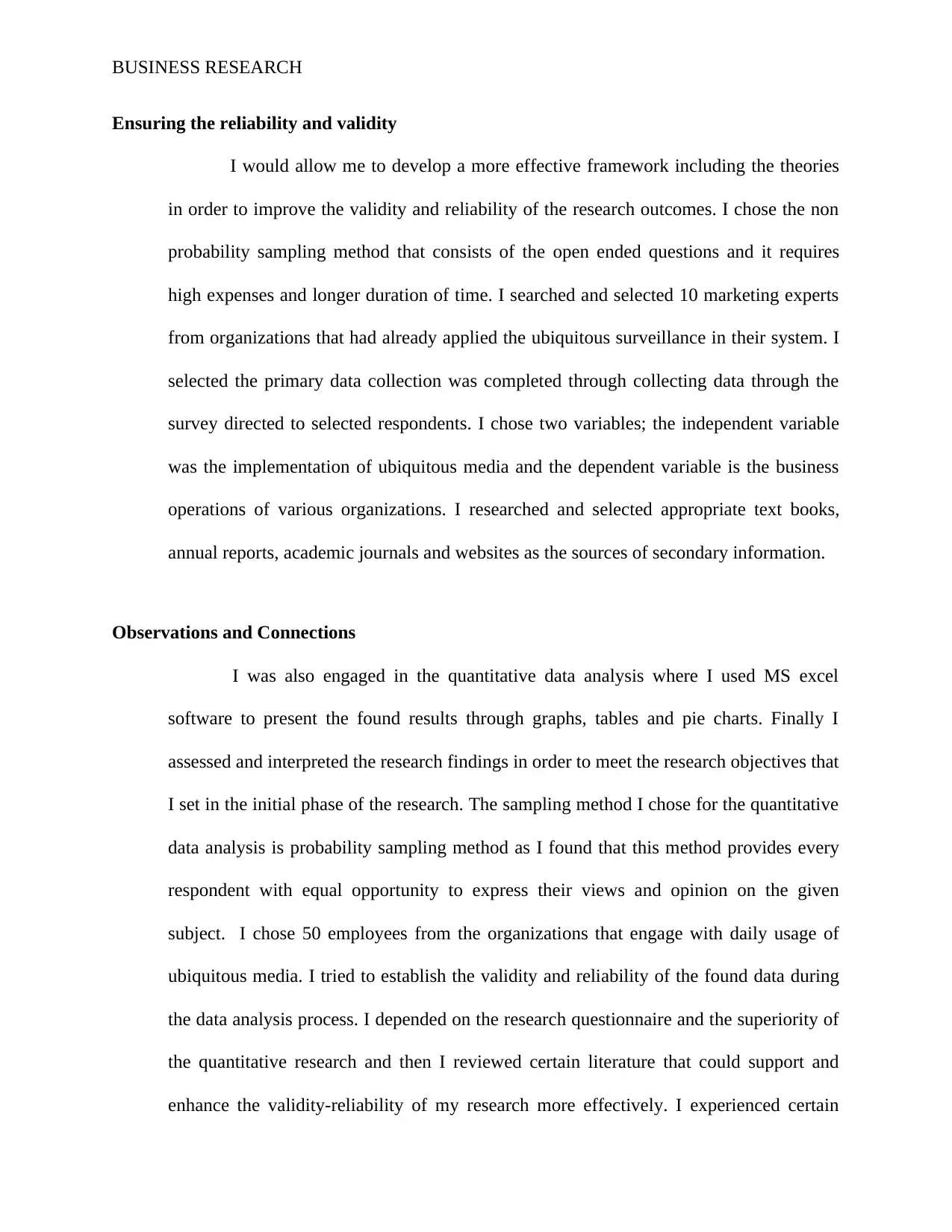
BUSINESS RESEARCH
Ensuring the reliability and validity
I would allow me to develop a more effective framework including the theories
in order to improve the validity and reliability of the research outcomes. I chose the non
probability sampling method that consists of the open ended questions and it requires
high expenses and longer duration of time. I searched and selected 10 marketing experts
from organizations that had already applied the ubiquitous surveillance in their system. I
selected the primary data collection was completed through collecting data through the
survey directed to selected respondents. I chose two variables; the independent variable
was the implementation of ubiquitous media and the dependent variable is the business
operations of various organizations. I researched and selected appropriate text books,
annual reports, academic journals and websites as the sources of secondary information.
Observations and Connections
I was also engaged in the quantitative data analysis where I used MS excel
software to present the found results through graphs, tables and pie charts. Finally I
assessed and interpreted the research findings in order to meet the research objectives that
I set in the initial phase of the research. The sampling method I chose for the quantitative
data analysis is probability sampling method as I found that this method provides every
respondent with equal opportunity to express their views and opinion on the given
subject. I chose 50 employees from the organizations that engage with daily usage of
ubiquitous media. I tried to establish the validity and reliability of the found data during
the data analysis process. I depended on the research questionnaire and the superiority of
the quantitative research and then I reviewed certain literature that could support and
enhance the validity-reliability of my research more effectively. I experienced certain
Ensuring the reliability and validity
I would allow me to develop a more effective framework including the theories
in order to improve the validity and reliability of the research outcomes. I chose the non
probability sampling method that consists of the open ended questions and it requires
high expenses and longer duration of time. I searched and selected 10 marketing experts
from organizations that had already applied the ubiquitous surveillance in their system. I
selected the primary data collection was completed through collecting data through the
survey directed to selected respondents. I chose two variables; the independent variable
was the implementation of ubiquitous media and the dependent variable is the business
operations of various organizations. I researched and selected appropriate text books,
annual reports, academic journals and websites as the sources of secondary information.
Observations and Connections
I was also engaged in the quantitative data analysis where I used MS excel
software to present the found results through graphs, tables and pie charts. Finally I
assessed and interpreted the research findings in order to meet the research objectives that
I set in the initial phase of the research. The sampling method I chose for the quantitative
data analysis is probability sampling method as I found that this method provides every
respondent with equal opportunity to express their views and opinion on the given
subject. I chose 50 employees from the organizations that engage with daily usage of
ubiquitous media. I tried to establish the validity and reliability of the found data during
the data analysis process. I depended on the research questionnaire and the superiority of
the quantitative research and then I reviewed certain literature that could support and
enhance the validity-reliability of my research more effectively. I experienced certain
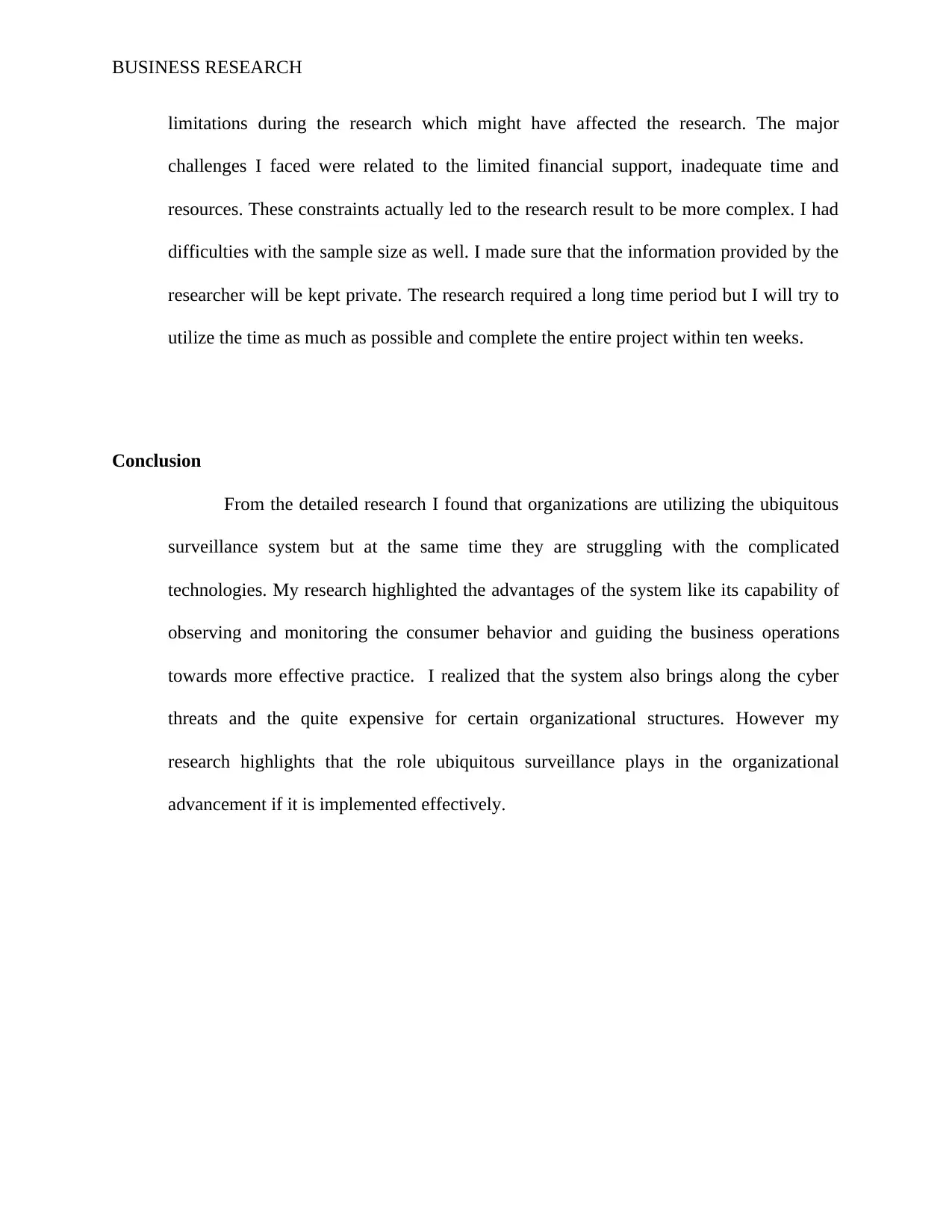
BUSINESS RESEARCH
limitations during the research which might have affected the research. The major
challenges I faced were related to the limited financial support, inadequate time and
resources. These constraints actually led to the research result to be more complex. I had
difficulties with the sample size as well. I made sure that the information provided by the
researcher will be kept private. The research required a long time period but I will try to
utilize the time as much as possible and complete the entire project within ten weeks.
Conclusion
From the detailed research I found that organizations are utilizing the ubiquitous
surveillance system but at the same time they are struggling with the complicated
technologies. My research highlighted the advantages of the system like its capability of
observing and monitoring the consumer behavior and guiding the business operations
towards more effective practice. I realized that the system also brings along the cyber
threats and the quite expensive for certain organizational structures. However my
research highlights that the role ubiquitous surveillance plays in the organizational
advancement if it is implemented effectively.
limitations during the research which might have affected the research. The major
challenges I faced were related to the limited financial support, inadequate time and
resources. These constraints actually led to the research result to be more complex. I had
difficulties with the sample size as well. I made sure that the information provided by the
researcher will be kept private. The research required a long time period but I will try to
utilize the time as much as possible and complete the entire project within ten weeks.
Conclusion
From the detailed research I found that organizations are utilizing the ubiquitous
surveillance system but at the same time they are struggling with the complicated
technologies. My research highlighted the advantages of the system like its capability of
observing and monitoring the consumer behavior and guiding the business operations
towards more effective practice. I realized that the system also brings along the cyber
threats and the quite expensive for certain organizational structures. However my
research highlights that the role ubiquitous surveillance plays in the organizational
advancement if it is implemented effectively.
⊘ This is a preview!⊘
Do you want full access?
Subscribe today to unlock all pages.

Trusted by 1+ million students worldwide
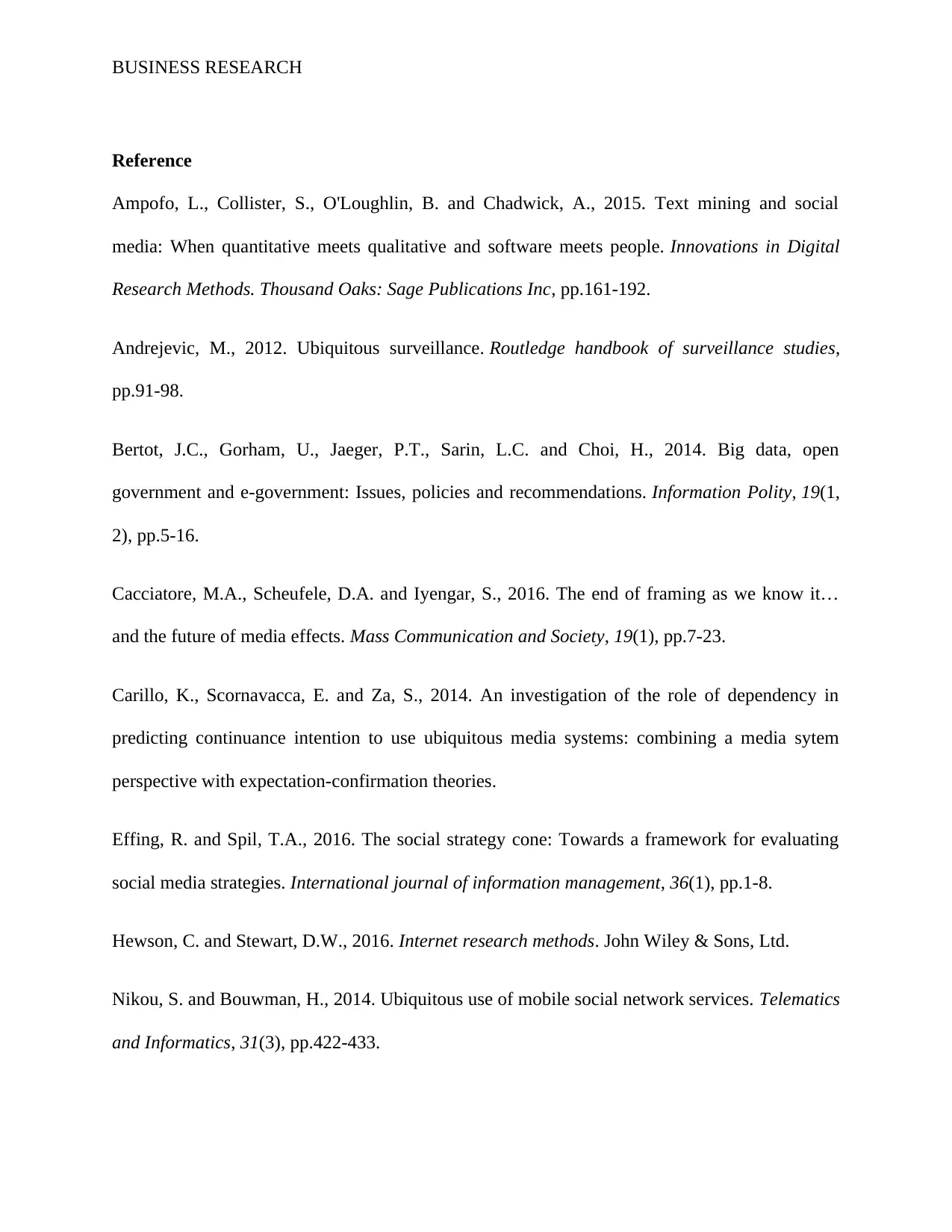
BUSINESS RESEARCH
Reference
Ampofo, L., Collister, S., O'Loughlin, B. and Chadwick, A., 2015. Text mining and social
media: When quantitative meets qualitative and software meets people. Innovations in Digital
Research Methods. Thousand Oaks: Sage Publications Inc, pp.161-192.
Andrejevic, M., 2012. Ubiquitous surveillance. Routledge handbook of surveillance studies,
pp.91-98.
Bertot, J.C., Gorham, U., Jaeger, P.T., Sarin, L.C. and Choi, H., 2014. Big data, open
government and e-government: Issues, policies and recommendations. Information Polity, 19(1,
2), pp.5-16.
Cacciatore, M.A., Scheufele, D.A. and Iyengar, S., 2016. The end of framing as we know it…
and the future of media effects. Mass Communication and Society, 19(1), pp.7-23.
Carillo, K., Scornavacca, E. and Za, S., 2014. An investigation of the role of dependency in
predicting continuance intention to use ubiquitous media systems: combining a media sytem
perspective with expectation-confirmation theories.
Effing, R. and Spil, T.A., 2016. The social strategy cone: Towards a framework for evaluating
social media strategies. International journal of information management, 36(1), pp.1-8.
Hewson, C. and Stewart, D.W., 2016. Internet research methods. John Wiley & Sons, Ltd.
Nikou, S. and Bouwman, H., 2014. Ubiquitous use of mobile social network services. Telematics
and Informatics, 31(3), pp.422-433.
Reference
Ampofo, L., Collister, S., O'Loughlin, B. and Chadwick, A., 2015. Text mining and social
media: When quantitative meets qualitative and software meets people. Innovations in Digital
Research Methods. Thousand Oaks: Sage Publications Inc, pp.161-192.
Andrejevic, M., 2012. Ubiquitous surveillance. Routledge handbook of surveillance studies,
pp.91-98.
Bertot, J.C., Gorham, U., Jaeger, P.T., Sarin, L.C. and Choi, H., 2014. Big data, open
government and e-government: Issues, policies and recommendations. Information Polity, 19(1,
2), pp.5-16.
Cacciatore, M.A., Scheufele, D.A. and Iyengar, S., 2016. The end of framing as we know it…
and the future of media effects. Mass Communication and Society, 19(1), pp.7-23.
Carillo, K., Scornavacca, E. and Za, S., 2014. An investigation of the role of dependency in
predicting continuance intention to use ubiquitous media systems: combining a media sytem
perspective with expectation-confirmation theories.
Effing, R. and Spil, T.A., 2016. The social strategy cone: Towards a framework for evaluating
social media strategies. International journal of information management, 36(1), pp.1-8.
Hewson, C. and Stewart, D.W., 2016. Internet research methods. John Wiley & Sons, Ltd.
Nikou, S. and Bouwman, H., 2014. Ubiquitous use of mobile social network services. Telematics
and Informatics, 31(3), pp.422-433.
Paraphrase This Document
Need a fresh take? Get an instant paraphrase of this document with our AI Paraphraser
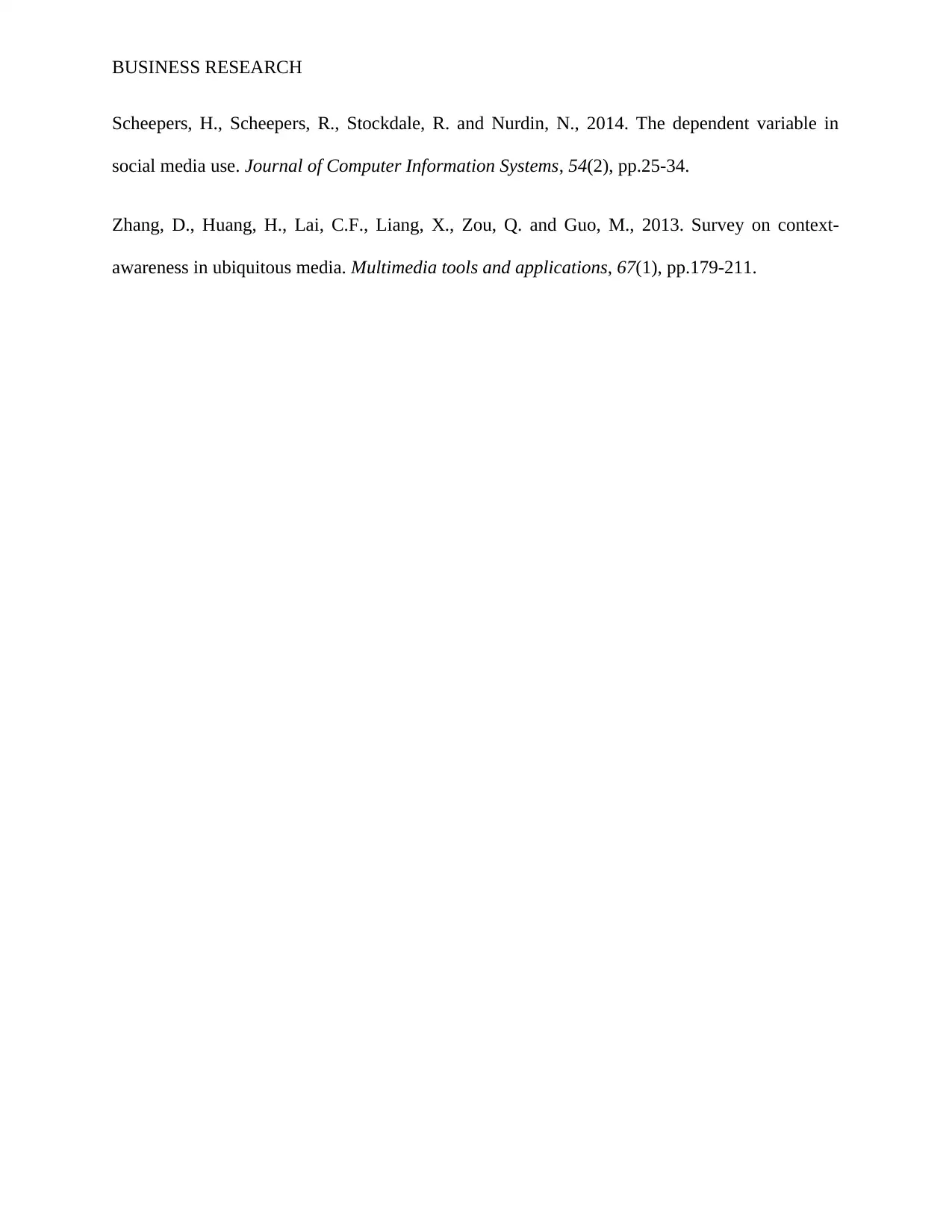
BUSINESS RESEARCH
Scheepers, H., Scheepers, R., Stockdale, R. and Nurdin, N., 2014. The dependent variable in
social media use. Journal of Computer Information Systems, 54(2), pp.25-34.
Zhang, D., Huang, H., Lai, C.F., Liang, X., Zou, Q. and Guo, M., 2013. Survey on context-
awareness in ubiquitous media. Multimedia tools and applications, 67(1), pp.179-211.
Scheepers, H., Scheepers, R., Stockdale, R. and Nurdin, N., 2014. The dependent variable in
social media use. Journal of Computer Information Systems, 54(2), pp.25-34.
Zhang, D., Huang, H., Lai, C.F., Liang, X., Zou, Q. and Guo, M., 2013. Survey on context-
awareness in ubiquitous media. Multimedia tools and applications, 67(1), pp.179-211.
1 out of 8
Related Documents
Your All-in-One AI-Powered Toolkit for Academic Success.
+13062052269
info@desklib.com
Available 24*7 on WhatsApp / Email
![[object Object]](/_next/static/media/star-bottom.7253800d.svg)
Unlock your academic potential
Copyright © 2020–2025 A2Z Services. All Rights Reserved. Developed and managed by ZUCOL.




